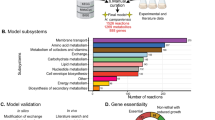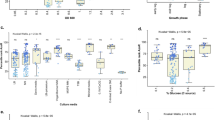Abstract
The current problem for metabolic engineering is how to identify a suitable set of genes for knockout that can improve the production of certain metabolites and sustain the growth rate from the thousands of metabolic networks which are complex and combinatorial. Some approaches, such as OptKnock and OptGene, are developed to enhance the production of desired metabolites. However, the performances of these approaches are suboptimal and the obtained results are unsatisfactory because of computational limitations such as local minima. In this paper, we propose a hybrid of Bat Algorithm and Flux Balance Analysis (BATFBA) to enhance succinate and lactate production by identifying a set of genes for knock out. The Bat Algorithm is an optimisation algorithm, whereas Flux Balance Analysis (FBA) is a mathematical approach to analyse the flow of metabolites through a metabolic network. The Escherichia coli iJR904 dataset was used to determine optimal knockout genes, production rate, and growth rate. By applying this hybrid method to the iJR904 dataset, we found that BATFBA yielded better results than existing methods, such as OptKnock and a hybrid of Artificial Bee Colony algorithms and Flux Balance Analysis (ABCFBA), at predicting succinate and lactate production.
Similar content being viewed by others
References
Schilling, C. H. and B. O. Palsson (2000) Assessment of the metabolic capabilities of Haemophilus influenzae Rd through a genome-scale pathway analysis. J. Theor. Biol. 203: 249–283.
Varma, A. and B. O. Palsson (1993) Metabolic capabilities of Escherichia Coli. II. Optimal growth patterns. J. Theor. Biol. 165: 503–522.
Majewski, R. A. and M. M. Domach (1990) Simple constrained optimization view of acetate overflow in Escherichia Coli. Biotechnol. Bioeng. 35: 732–738.
Ramakrishna, R., J. S. Edwards, A. McCulloch, and B. O. Palsson (2001) Flux balance analysis of mitochondrial energy metabolism: Consequences of systemic stoichiometric constraints. Am. J. Physiol. Regul. Integr. Comp. Physiol. 280: R695–704.
Varma, A. and B. O. Palsson (1994) Metabolic flux balancing: Basic concepts, scientific and practical use. BioTechnol. 12: 994–998.
Burgard, A. P., P. Pharkya, and C. D. Maranas (2003) OptKnock: A bilevelprogramming framework for identifying gene knockout strategies for microbial strain optimization. Biotechnol. Bioeng. 84: 647–657.
Patil, K. R., I. Rocha, J. Forster, and J. Nielsen (2005) Evolutionary programming as a platform for in silico metabolic engineering. BMC Bioinformatics 6: 308.
Whitley, D. (1994) A genetic algorithm tutorial. Stat. Comput. 4: 65–85.
Rocha, M., P. Maia, R. Mendes, J. P. Pinto, E. C. Ferreira, J. Nielsen, K. R. Patil, and I. Rocha (2008) Natural computation meta-heuristics for the in-silico optimization of microbial strains. BMC Bioinformatics 9: 1–16.
Zhu, Y., M. A. Eiteman, K. D. Witt, and E. Altman (2007) Homolactate fermentation by metabolically engineered Escherichia Coli strains. Appl. Environ. Microbiol. 73: 456–464.
Chang, D. E., H. C. Jung, J. S. Rhee, and J. G. Pan (1999) Homofermentative production of D- or L-lactate in metabolically engineered Escherichia Coli RR1. Appl. Environ. Microbiol. 65: 1384–1389.
Mahadevan, R., A. P. Burgard, I. Famili, S. V. Dien, and H. S. Christophe (2005) Applications of metabolic modeling to drive bioprocess development for the production of value-added chemicals. Biotechnol. Bioproc. Eng. 10: 408–417.
Soh, K. C. and V. Hatzimanikatis (2010) DREAMS of metabolism. Trends Biotechnol. 28: 501–508.
Edward, J. S., R. U. Ibarra, and B. O. Palsson (2001). Insilico predictions of Escherichia Coli metabolic capabilities are consistent with experimental data. Nat. Biotechnol. 19: 125–130.
Atsumi, S. and J. C. Liao (2008) Metabolic engineering for advanced biofuels production from Escherichia Coli. Curr. Opin. Biotechnol. 19: 414–419.
Gomes, L. C. and M. Simoes (2012). 13C Metabolic flux analysis: From the principle to recent applications. Curr. Bioinform. 7: 77–86.
Choon, Y. W., M. S. Mohamad, S. Deris, R. M. Illias, C. K. Chong, L. E. Chai, S. Omatu, and J. M. Corchado (2014) Differential bees flux balance analysis with OptKnock for in silico microbial strains optimization. PLoS One 9: e102744.
Kennedy, J. and R. Eberhart (1995) Particle swarm optimization. Proceeding of the 1995 IEEE on Neural Networks. Perth, WA: IEEE.
Elbeltagia, E., T. Hegazyb, and D. Griersonb (2005) Comparison among five evolutionary-based optimization algorithms. Adv. Eng. Inform. 19: 43–53.
Orth, J. D., I. Thiele, and B. Palsson (2010) What is flux balance analysis. Nat. Biotechnol. 28: 245–248.
Yang, X. S. (2010) A new metaheuristicbat-inspired algorithm. pp. 65–74. In: C. Cruz, J. Gonzalez, N. Krasnogor, and G. Terraza (eds.). Nature Inspired Cooperative Strategies for Optimization. Granada, Spain.
Yang, X. S. (2011) Bat Algorithm for multi-objective optimiza tion. Internat. J. Bio-Inspired Comput. 3: 267–274.
Tsai, P. W., J. S. Pan, B. Y. Liao, M. J. Tsai, and V. Istanda, (2011) Bat algorithm inspired algorithm for solving numerical optimization problems. Appl. Mech. Mat.148–149: 134–137.
Reed, J. L., T. D. Vo, C. H. Schilling, and B. O. Palsson (2003) An expanded genome-scale model of Escherichia Coli K-12 (iJR904 GSM/GPR). Genome Biol. 4: 1–12.
Geem, Z. W., J. H. Kim, and G. V. Loganathan (2001) A new heuristic optimization algorithm: Harmony search. Simulation 76: 60–68.
Sureja, N. (2012) New inspirations in nature: A survey. Internat. J. Computer Appl. Informat. Technol. 1: 21–24.
Sanchez, A. M., G. N. Bennett, and K. Y. San (2005) Novel pathway engineering design of the anaerobic central metabolic pathway in Escherichia Coli to increase succinate yield and productivity. Metabol. Eng. 7: 229–239.
Li, M., P. Y. Ho, S. Yao, and K. Shimizu (2006) Effect of lpd-Agene knockout on the metabolism in Escherichia Coli based in enzyme activities, intracellular metabolite concentrations and metabolic flux analysis by 13C-labeling experiments. J. Biotechnol. 122: 254–266.
Lee, S. Y., D. Y. Lee, T. K. Kim, B. H. Kim, and S. J. Lee (2005) Systems biotechnology: Combined in silico and omicsanalyses for the improvement of microorganisms for industrial applications. pp. 193–231. In: I. Rigoutsos and G. Stephanopoulos (eds.). Systems Biology Volume II: Networks, Models, and Applications. NY, USA.
Bohl, K., L. F. Figueiredo, O. Hadicke, and S. Klamt (2010) CASOP GS: Computing intervention strategies targeted at production improvement in genome-scale metabolic networks. German Conference on Bioinformatics. September 20–22. Braunschweig, Germany.
Zhu, J. and K. Shimizu (2004) Effect of a single-gene knockout on the metabolic regulation in Escherichia Coli for D-lactate production under micro aerobic condition. J. Metabolic. Eng. 7: 104–115.
Zhu, J. and K. Shimizu (2003) The effect of pfl gene knockout on the metabolism for optically pure D-lactate production by Escherichia Coli. Appl. Microbial. Biotechnol. 64: 367–375.
Hong, S. H. (2007) Systems approaches to succinic acid producing microorganisms. Biotechnol. Bioproc. Eng. 12: 73–79.
Lee, S. S. (2013) A hybrid of artificial bee colony and flux balance analysis for identifying optimum knockout strategies for producing high yields of lactate in Escherichia Coli. Adv. In Biomed. Infrastructure 477: 127–137.
Author information
Authors and Affiliations
Corresponding author
Rights and permissions
About this article
Cite this article
Chua, P.S., Salleh, A.H.M., Mohamad, M.S. et al. Identifying a gene knockout strategy using a hybrid of the bat algorithm and flux balance analysis to enhance the production of succinate and lactate in Escherichia coli . Biotechnol Bioproc E 20, 349–357 (2015). https://doi.org/10.1007/s12257-014-0466-x
Received:
Revised:
Accepted:
Published:
Issue Date:
DOI: https://doi.org/10.1007/s12257-014-0466-x




